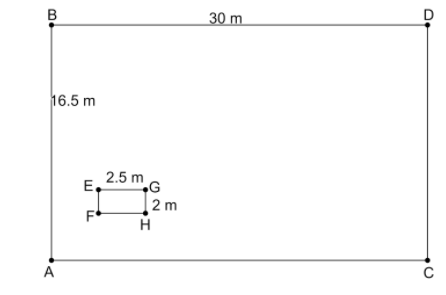
How many paving stones each measuring $2.5m\times 2m$ are required to pave a rectangular courtyard 30 m long and 16.5 m wide?
(a) 105
(b) 89
(c) 99
(d) 84
Answer
558k+ views
Hint: We start solving the problem by drawing the figure representing the given information. We then find the area of the paving court and paving stone by using the fact that the area of the rectangle with length ‘l’ and breadth ‘b’ is $l\times b$. We then divide the area of the paving court with the area of the paving stone to find the total number of paving stones required to fill the court.
Complete step by step answer:
According to the problem, we are asked to find the total number of paving stones each measuring $2.5m\times 2m$ are required to pave a rectangular courtyard 30 m long and 16.5 m wide.
Let us draw the diagram representing the given information.

In the figure, ABCD is the ground that needs to be paved and EFGH be one of the paving stones.
From the figure, we can see that ABCD resembles the rectangle with length 30 m and breadth 16.5 m. We know that the area of the rectangle with length ‘l’ and breadth ‘b’ is $l\times b$.
So, we get the area of the paving court as ${{A}_{1}}=16.5\times 30=495{{m}^{2}}$ ---(1).
From the figure, we can see that EFGH resembles the rectangle with length 2.5 m and breadth 2 m.
So, we get the area of paving stones as ${{A}_{2}}=2.5\times 2=5{{m}^{2}}$ ---(2).
Now, let us find the total number of paving stones required to fill the court. So, the number of paving stones required = $\dfrac{495}{5}=99$.
So, we have found that 99 paving stones are required to pave the court.
So, the correct answer is “Option C”.
Note: Whenever we get this type of problem, we first need to draw the figure representing the figure as we can see that figure provided half the answer. We should know that the total area of the court has to be covered with the paving stone. We should not make calculation mistakes while solving this problem. Similarly, we can expect problems to find the percentage of area of one paving stone in the area of the court that is to be paved.
Complete step by step answer:
According to the problem, we are asked to find the total number of paving stones each measuring $2.5m\times 2m$ are required to pave a rectangular courtyard 30 m long and 16.5 m wide.
Let us draw the diagram representing the given information.

In the figure, ABCD is the ground that needs to be paved and EFGH be one of the paving stones.
From the figure, we can see that ABCD resembles the rectangle with length 30 m and breadth 16.5 m. We know that the area of the rectangle with length ‘l’ and breadth ‘b’ is $l\times b$.
So, we get the area of the paving court as ${{A}_{1}}=16.5\times 30=495{{m}^{2}}$ ---(1).
From the figure, we can see that EFGH resembles the rectangle with length 2.5 m and breadth 2 m.
So, we get the area of paving stones as ${{A}_{2}}=2.5\times 2=5{{m}^{2}}$ ---(2).
Now, let us find the total number of paving stones required to fill the court. So, the number of paving stones required = $\dfrac{495}{5}=99$.
So, we have found that 99 paving stones are required to pave the court.
So, the correct answer is “Option C”.
Note: Whenever we get this type of problem, we first need to draw the figure representing the figure as we can see that figure provided half the answer. We should know that the total area of the court has to be covered with the paving stone. We should not make calculation mistakes while solving this problem. Similarly, we can expect problems to find the percentage of area of one paving stone in the area of the court that is to be paved.
Recently Updated Pages
Master Class 9 Social Science: Engaging Questions & Answers for Success

Master Class 9 Science: Engaging Questions & Answers for Success

Master Class 9 English: Engaging Questions & Answers for Success

Master Class 9 Maths: Engaging Questions & Answers for Success

Master Class 11 Economics: Engaging Questions & Answers for Success

Master Class 11 English: Engaging Questions & Answers for Success

Trending doubts
Which places in India experience sunrise first and class 9 social science CBSE

Fill the blanks with the suitable prepositions 1 The class 9 english CBSE

Write the 6 fundamental rights of India and explain in detail

Difference Between Plant Cell and Animal Cell

What is the Full Form of ISI and RAW

Golden Revolution is related to AFood production BOil class 9 social science CBSE




